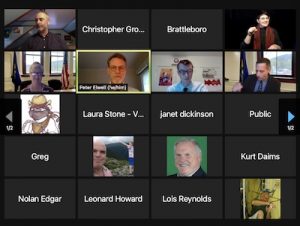The Brattleboro Selectboard met on the last evening of summer, and heard big news. Steve Barrett, long-time employee of the Town, will be retiring and Dan Tyler will be taking his place. The switch happens in December.
There was discussion of racism in the community, COVID safety at the Stone Church, stormwater plans, designs for and objections to a new bridge on Western Ave, and more.









Preliminaries
Pre-meeting banter about… getting lost in zoom, virtual commutes, Star Trek, Harry Potter, lost members of the board recently seen in executive session, a beautiful day today but rain later.
Chair Elizabeth McLoughlin – Jessica Gelter can’t join us tonight. I have a few remarks. It’s going to be an interesting meeting tonight. Some state initiatives, town staff, and groups collaborating for the town. We can see how these actions are informed by the community safety concerns, but it is important to note that the Town’s role is supportive or administrative. All this good work is playing against our shared goals for anti-racism. It is particularly disheartening when we learn racists are at play in town and the actions against our police chief this weekend was very sad. We have work to do in this town and need to be vigilant in this town to combat racism and continue with the work we pledged to do.
Town manager Elwell – 2 topics – This morning’s paper included a story about the offensive memes at the town’s facebook page. I’m happy for the department’s response, for not calling out the individual but mentioning the policy overall. It was important that they showed restraint. I was grateful for the way the community rallied around Chief Hardy with a broad range of responses. A cross section of the community demonstrating we won’t tolerate this, but I was saddened that we still have racism and hate. It shows the importance of our anti racism work, institutionally and person to person. Second, there is more town staff transition – I’m advising tonight of something we’ve been discussing for a while – Steve Barrett will retire in December…he rose quickly to positions of leadership, after 47 years of service, and 25 as senior management. He has been involved in two wastewater upgrades, the planning of the replacement date rplant, the retreat well work, storage tanks, rerouting traffic and roads, and the recovery from numerous emergencies and winter storms. During Irene, he saved us time and resources. If you need to know about town changes in the last five decades, you ask Steve. Thank you Steve. He prepared DPW with a succession plan for a smooth transition. He brought on Dan Tyler, who has done outstanding work. When I learned of Steve’s retirement, we found that Dan was ready to step up. Dan’t promotion will happen Dec 18 when Steve retires.
Liz – Super, okay.
Tim Wessel – I was expecting to give an update on the cannabis control board. When the article appeared and I saw the posts, I’m reluctant to give more power to a very small few who have these ugly views. It is important to move past that and welcome people to the community. It’s our mission to make Brattleboro the most welcoming that we can going forward. Our new police chief will be fine. I’m concerned about other people’s feeling around this and we are committed to supporting a non-racists and welcoming. And wow, 1974… I barely remember the year. It’s amazing. Steve lives across the street from me. I wish him the best. Similar to Peter, he is leaving a legacy behind. The advisory committee – I’m the sole rep for municipalities. It is a whirlwind of meetings. The subcommittees alone meet twice a day Monday and Wednesday. I’m on public health with Dr Levine talking about labelling, packaging, ad rules , and what other states do. The other committee is compliance and enforcement. Who’s going to be watching the shop when it comes to retail and medicinal… some discussion of local taxes and fees. VLCT is helping to help stick up for the rights of municipalities. So, that’s my quick update.
Liz – thanks for that service.
Ian Goodnow – thanks for your words on the incident. Just to say it is unacceptable to me. It shows one of the many reminders living in Vermont that there is so much more work to be done and grateful this board will commit to it. And Steve, thanks for your service. Water & Sewer I like to talk about. I have sent Steve a lot of emails deep diving on little things. So knowledgeable and kind walking me through it and sharing his passion for it. Thanks so much and congrats on your retirement.
Daniel Quipp – “we acknowledge that centuries of white people holding power has perpetuated hard in the country and in Brattleboro.” – I’m not surprised by this and Chief Hardy wouldn’t be. I hope the police investigate if there is stuff to investigate. Our commenting on this will lead to more of it. It is endemic. Chief Hardy has dedicated her life to public service and is exceptionally qualified. We will stand with her. Steve, congrats, Dan, congrats to you.
Liz – again, congrats to Steve and Dan and didn’t know Ian was such a sparkling conversationalist.
Public – none
Consent Agenda
A. Recommendation for Appointment of Deputy Health Officer – Fire Inspector Eric Davis
B. Monthly Financial Report – Through August (First 2 Months of FY22)
C. Two Police Cruisers – Authorize Purchase
so consented….
Liquor Commissioners
Stone Church – Outside Consumption Permit
Elwell – tonight Robin Johnson and Sue Fillion are here to talk about this. She’s relevant because this is focused on COVID safety, and the DRB considered all of this and the outside area. DRB gave temporary approval until next april. Tonight, staff recommends along with the DRB, for you to approve this permit where the consumption is outside on the lawn, and people indoors will be masked and enjoying the performance.
Liz – are we granting a temporary outside consumption permit
Elwell – you grant it and the state DLC approves. The only thing unusual is that it is specifically now for COVID safety.
Liz – is our license temporary?
Hillary Francis – it would be until 2022, temporary til spring. When they go to renew next spring, if they want, then the DRB would like to review it again and it would go to you like any other renewal.
Sue Fillion – Hilary and Peter covered it. The DRB felt comfortable issuing it as a COVID measure, but if it is long term they might require more.
Robin Johnson – cases have gone up, promoters have more stringent protocols, and we implement the most strict for our shows. It’s 100% mask mandate indoors. My thought is that is we have a bar and a mask mandate, it doesn’t work. To make it easier, we want to move all concessions outside. We’ve had a few shows like that. It’s more work for less income, but the only way to move forward safely. We’ve talked about our shows not being economically sustainable during this period, so we want to use the space to sell food and stuff in off periods. We’re interested in expanding it until things become more normal again.
Daniel – thanks for the creative, safe solution. This is a good work around. I hope in the colder days people bundle up, but I appreciate it and am glad your organization is here.
Ian – A shout out… I was walking out when the accessibility ramp was being put in. Glad to see that. Can you explain to me what it will look like – in front of the ramp in the grass area, and installed bar?
Robin – the way we have it now is fence posts with poly rope along the perimeter and about two pop up tents between the ramp and the building, and we have our food cart below the large south window on the Grove Street side.. we bring out tables and chairs. We don’t have a permanent bar setup. We have a small pocky boxx that serves draft beers, then load it back in at the end of the night. Nothing permanent.Later on, we might look at landscaping and building, but now it can be removed easily.
Tim Wessel – full support to a creative réponse. You are providing extra reassurance who might not feel comfy going to a place without requirements. It’s great that you are doing it and a great venue. Hopefully you’ll get some people who appreciate the extra safety.
Liz – I’ve been many times and people went outside anyway for a breath of fresh air.
Approved!
Brattleboro BF 2000(28) 12J608, Town Highway 2 (VT Route 9), Bridge 54 over the Whetstone Brook – Vermont Agency of Transportation’s Presentation of Alternatives
(Quipp asks to first adjourn as liquor and sewer commissioners )
Elwell – for several years we have been urging replacement on the bridge over the Whetstone in West Brattleboro Village near exit 2. The state is undertaking the project and VTRANS are here to present their project and alternatives.
Laura Stone – I have to share me screen. I have a powerpoint. Can you see the screen? Thanks for introduction. It is an exciting project for the town. This is the alternative presentation meeting. I’m the scoping engineer, and Gary Laroche will be the project manager on site. We have a historic preservation specialist, and Nick the hydraulics engineer, and the RPC Colin. We want to provide our approach to the project, the constraints, the funding, the alternatives, and to take questions and concerns. So, here’s the location map, just to the west of Melrose street. On VT RT 9.
The development process is that we get funding and define the project – we’re early in the timeline now. This is for public participation, building consensus . Then the project gets defines, permits are obtained, and we develop plans. Form there to contract award and construction. The current bridge is an arch structure, but the new one will have the deck to ride on, the beams and deck are the superstructure. The support is known as the substructure. In 2012 the state said the local share is reduced for rehab. It’s in an urban area, on a Class 1 town highway. The bridge now is 60′ cast in place concrete arch from 1914 and is considered historic. It has a 4 foot sidewalk but we need 5 feet nowadays. It’s in a densely populated area, and it is narrow. There are two 11 foot travel lanes with 1 foot shoulders. Now it needs 10 ft shoulders. The sidewalk is in poor condition. The barrel of the arch is cracking, there is leakage in the concrete. There is a water line going through it. There is heavy abrasion. The width is too narrow by 18 feet. The arch blocks high flood flows. Water is infiltrating into the arch, causing chemical reactions. It is satisfactory rated in condition. Original railing is gone. The water line is exposed.
There is a bat habit, so we have to watch the time of year. There are archeological and historic resources in the area, and FEMA floodplains. Quite a few utilities. Debris blockage – existing conditions were modeled and we found there is no freeboard and 1% AEP.
Existing conditions map is shown. There’s a 1-2% grade in the road.
Design criteria ADT of 17, 500 vehicles per day. That’s extremely high, more than the interstate. The design hourly volume peak is 1,700. Design speed of 30 mph for cars.
Alternatives considered:
No action – means more maintenance. We didn’t consider this.
Arch Rehab – it would be rebuilt. 40 year design line. No change to width. new railing and sidewalks. Improved hydraulics. Repairs to foundation.
Arch Rehab plus widening – arch reconstructed plus new steel beams on the side. 30 year design life. We’d remove spandrel walls, new railing, new pavement and sidewalk.
Full replacement with new arch – meets standards, improves hydraulics, 100 year design life. We recommend a sidewalk on both sides.
Full bridge with conventional bridge – more economical and easier to build, meets standard widths, helps hydraulics, and 100 year design life. 11 for travel lanes, sidewalk on both sides.
(shows pictures of each.)
We wouldn’t recommend changing the profile of the road – no raising or lowering. Our recommendation is a full bridge replacement, based on the grossly substandard width, and there are hydraulic concerns with the existing structure. We would construct to the minimum standards. Span length of 75 feet. The skew would be 40 degrees. We’d want a shallow superstructure to let more water get through during a high flow event. 100 year design life.
To maintain traffic – we could do phased construction – one half a bridge at a time. Can’t do it here. That leaves us with an offsite detour and temporary bridge. The shortest rt around is 3.7 miles – a 60 day bridge closure, and a separate route for truck over 60 miles. That’s what we remained. RT 9 to Orchard to Meadowbrook. We want to maintain pedestrians as well… Melrose Street. It’s .7 miles. Trucks would go to RT 9 to Rt 30… We’d need a two way temporary bridge and sidewalks. We recommend it on the downstream side (south). Houses too close on the other side. There is a play structure that the bridge goes through that would need to be relocated during construction. We recommend the conventional bridge. Aerial utility relocation will be needed, and municipal utility relocation will be needed. It will be extensive.
The costs – range from $2 million to $5.5 million. This one is $5.1 million with a temporary bridge. Town would owe $500k. Could cost $4.6 million with detour instead of bridge.
Construction would start in 2025 summer. Total cost $5.1 million, and $516k cost to the town.
Our next step is to wait for the town’s response to the alternatives. I’ll give you a sheet with a checklist and you can order 4b, or another alternative. After we hear from you we do plans for your comments, finalize agreements, discuss the conceptual plans, and start right of way process.
We have a project sharepoint site outside.vermont.gov/agency/vtrans/externalprojects/structures/12J608 ?
Liz – thanks. People have been asking for this for years. I’d appreciate the temporary bridge. Asking trucks to go so far is not acceptable.
Daniel – thanks for the presentation. I’m in agreement with Liz – sidewalks and widening is really great. Looking at proposed plan, I noted that the real cost driver is the destroy vs the temporary bridge. I’m a realist about trucks using this route.
Laura – we look for the shortest route around on state highways. Rt 9 to Rt 30 and VT 100 back to Rt 9.
Daniel – that detour is a $300k cost savings.
Laura – yes – we build the bridge and the road to it, and the town gets a different share if the road is kept open vs. closed.
Daniel – non truck traffic – Rt 9 to Orchard Street and meadow brook, back to Rt 9.
Tim – looking at town costs, it would more than double towns costs to have a temporary bridge, but it would be batty to do it the other way. I can’t imagine the community choosing the detours. Does the recommend plan increase resiliency for future floods?
Laura… Nick?
Nick – Hydraulics engineer – these will be larger than the existing one, and won’t have dangling utilities. It will improve things. It’s a low road, and we can solve all the overtopping problem. There was a couple feet over during Irene. If this was a 500 year storm the price would go up. We do 50 year storms.
Tim – the replacement in 35 years is depressing.
Ian – I’ve just been absorbing all the information. It makes sense to go for the design that lasts the longest, because it will cost a lot and disrupt us. I’m curious… if we went for the temporary bridge detour it is still 10 months to build the temporary bridge?
Laura – yea – 18 months. Sometimes the contractor will do it in the fall before construction. It doesn’t mean it will be done like that. It could be done in the same construction year.
Liz – it isn’t 18 months of traffic disturbance.
Laura – yeah, at the most, when we are transitioning cars to the new alignment of the temporary bridge and back at the end. But it would be maintained. Maybe some reduced traffic speeds.
Daniel – what communication has happened with adjoining land owners?
Laura – not much. Before scaring people, we want to make sure we are doing it. One property did reach out with flood pictures and were supportive of the project. They’ll be compensated for the right of way. If they don’t want to give it up, there is a way to prove necessity by the Town.
Gary Laroche – we reach out when we have preliminary plans, before we get into developing right of way documents. Early in the design, to take concerns into consideration, like utility poles. We try to be accommodating.
Public – Aaron Smith, next to the bridge. I have many concerns. I think the replacement is needed. I see the traffic every day. My quality of life and piece of property, with trees lining the avenue. My view now is trees, that will all need to be removed with this bridge. The trajectory removes the play structure, then goes through my driveway. I’ll get light pollution, greater noise, the width of the bridge will take land away. I’m concerned about speed on a wider bridge. I’m thinking the quality of life during construction and after will be great and I am very concerned. Is there any adjusting this plan? Wondering if the road will be widened? People won’t stop for you. Traffic speeds. Surprised no one has reached out.
Liz – thanks.
Jennifer Smith – I run and jog there, I have no problem with he crosswalk on one side only. The sidewalk ends after our house, they are all in disarray. I go running and go to the crosswalk. The playhouse was built for our children who are very distraught and sad and don’t feel welcome anymore. There’s no where the breakdown lane is 10 feet on that road.
Laura – in terms of the construction – the final project has a widened road, close to your house. The addition of the sidewalk the Town can decide on. There will be removal of trees for the roadway widening. The negotiation process should take these concerns into consideration. We will plant new trees there that will take a while to grow in. We’d seed the yard after the temporary bridge. We’d brig things back to their existing condition, but a wider road. In terms of construction it is 2025. The playhouse can be moved to another suitable location on the lawn, and project fencing for the temporary roadway. Noise is limited during evenings. No construction at night.
Aaron – 17k cars driving through our yard every day.
Jennifer and lights and noise aimed at our house?
Aaron – how much wider? Can we get a site visit?
Laura – Town needs to decide what they want, then we can develop plans, then schedule property owner visits to discuss concerns at impacts?
Jennifer – we only have 8 feet of front yard right now…
Laura – we are widening it on both sides. It would be widening the road 18 feet total, plus the 5 feet of sidewalk.
Jennifer – no one does 35 out there. Widening it will speed things up. It will create safety issues for cars swerving around stopped cars. I wear all yellow because it is unsafe to cross the road, and my kids can’t cross alone.
Liz – this is the initial discussion, and more will be and. I’m hoping they will communicate.
Michael Bosworth – looking forward to a new bridge there. It is a choke point. It would help with biking. I hear the Smith’s… and whether a sidewalk is needed on both sides… the Town should think about that one. I’m on Meadowbrook Road. I would not like a detour. Selfishly, meadow brook got paved recently, and part of that route is dirt road. T have that many cars negotiate that during mud season would invite nothing good.
Gary Stroud – it’s raining Gary’s out here. I like the concept and idea. Duration? Design life years? Is the structure included with the design 100 years?
Laura – the new bridge would be designed to 100 years. Gary could speak to this. We use stainless steel reinforcement. It’s a bit more costly.
Gary – I’m on two committees about animals and climate change, and the flood zone, so factoring that in, would it cut back or cut down the design life? It’s highly likely it will be a case. It is a FEMA flood zone. What contingency is in place for that?
Laura – it will redesigned to take on flood waters. If we make it longer, the superstructure will be deeper and it makes a dam. We find the medium. It’s in a flood zone. It won’t be perfect but improved.
Gary – Nothing is guaranteed. Is it insured if that happens?
Liz – what you are discussing is beyond 100 years.
Gary that was my one concern – erosion in that area and climate damage.
Liz – I’m sure they are taking it into concern.
Other Gary – VTrans designs structures for scour resistance. The fill might get washed away, the the bridge will remain intact. Not extraordinary costs. We do consider those factors.
Nick – my teachings have worked. I deal with climate change daily. There are national and regional predictions – at local project levels we don’t use climate change… to many unknowns to apply. Not enough funding. We have structurally deficient strides on the network, and can’t fix those. To add another layer of climate change isn’t economically feasible. Projects do have a bit of a buffer. There may be some overtopping.
Liz – thanks to Laura, Nick and (Other) Gary.
Mr. Smith – due to numerous questions, who will reach out o me and when can I expect it?
Laura – Gary, in 6 months to a year – we need to get a design, town approval. Before then, reach out to me or Gary.
Smith – the bridge needs to be replaced. Before the planning is done, I’d rather talk sooner than later. I know it has to happen, but rather than wait until it is planned, I’d like a voice in expressing concerns and possible solutions . I live right there and have for 20 years. If someone reached out earlier, we could work together.
Nick – you should talk to the Town. We have a recommended alternative, but will only due what the town wants. Anything the town wants…. we can deal with selectboard and property owners. It would help if you worked together. It’s not a done deal. We’ll wait for a letter form the town about what alternative to proceed. W# have done site specific issues yet. We present everything in a public forum, and it is a dialogue until construction. VTrans is good working with property owners. Sometimes it is impossible and someone walks away unhappy. It’s a balancing act and we try to do the best.
Liz – contact Elwell and we’ll hear your concerns.
Laura – there are mitigations that can happen during construction period. The width of the road – we have state standards to design to. When we put this in place, it calls for an 11 foot travel lane and 11 foot shoulders. It is on the national highway standards – our minimum standard.
Nick – our executive staff can make those decisions; Laura and we can’t.
Laura – we match the corridor in some cases.
Elwell – yes, be in touch with me and we’ll talk and I’ll facilitate some additional communications with VTrans. They’ve been great with us in town so far – a really good partner. It is important that we engage sooner rather than later. Definitely before selectboard makes a decision in a fully formed manner. It has to include all of us, and Vtrans knows things we don’t know. It’ll be a VTrans project. Happy to work together to make that possible.
Liz – thanks VTrans for the presentation and thanks for thinking about our bridge. It is after 8 and we have to take break for the interpreters. Til 8:15.
Stormwater Management Master Plan and Feasibility Study
Liz – we’re back. Thanks. Moving on to a couple of other exciting things – stormwater management.
Elwell – a pair of items. Sue will tell us of an opportunity to create a stormwater plan for free, and the second items is Dany Tyler speaking to the results of a feasibility study about creating a stormwater utility. He’ll tell us about this finding. Then, what do we do next.
Sue Fillion – We’ve been told of a stormwater master plan being done for free by VT DEC. They are doing 8 master plans. The have been funding stormwater master plans, under Act 64. The state put out a RFP and hired watershed consultants. They’ll do a 3 year project, gathering information. They’ll look at 3 acre sites – if you have 3 acres of impervious surface you’ll need a permit. They’ll create that list for Brattleboro. They’ll look at 40 sites for best management practices, then rank it by feasibility. Then they’ll look more closely at some, then narrow it to three sites for implementing best practices. It’ll start about now, some public outreach, public and private. They’ll give us a lot of useful information and private landowners. The are aware we want a stormwater utility. All they ask for is a letter of intent to cooperate with them.
Elwell – this doesn’t need your action. If you were concerned you could tell us to stop, but if you are comfortable with this we’ll sign the letter and do the one thing we need to do to become a partner.
Liz – nodding heads – great!
Dany Tyler – So, we presented you with a stormwater feasibility study by Sevens & Associates. Stormwater costs are rising, we have more rules and regs, and permits for developments in town, and this 3 acre rule coming up. We’ve been talking about the utility for a while. This looks at it, compares to others, looks at fee structures, outlines steps we think we should take to move forward with the utility. First part is the stormwater master plan Sue talked about. We also recommend we do some deep deed research into existing stormwater responsibility. The state says 30 permits and we share responsibility on 8, but we may be linked to others. Bob Fisher will do the deed research and this can happen while master plan is happening. As it happens, some info could be used to move forward. We need to do financial planning, community stakeholders, then lay out the program with a fee structure, write ordinances. Stevens laid it out. It is evident we should work in that order. We’ll get info from each step to make the next easier. The utility looks very possible in Brattleboro.
Elwell – For those following this over the last few years, it is important to note that it would take a couple of years to start then implement. And, the first piece of work would be to do the kind of analysis for us. It will move a bit more slowly being in the DEC program, but a huge body of work will be done to move us forward, for free. A good trade off to town staff. With this report in hand, we can do other work until master plan is done. Feels like tonight is the night we are launching this project.
Liz – the fees will be fees primarily paid by the state?
Elwell – a little softer. The state’s role is important – they are a significant contributor to runoff into the system. The general principle is that stromwater can act as a utility to determine how much runoff contributes to stormwater management, and a formula allocates a great share to those with big parking lots compared to home owners. It’s a fair, fee based system. Right now we fund it through property taxes. It will become based on who uses it the most. Some non property tax payers will be stormwater utility payers – like the state and the interstate highways. Othe tax exempt properties will be assessed as a rate payer, like water and sewer.
Liz – stormwater management is an environmental benefit.
Ian – a depp dive question. I look at the feasibility study -it’s great – if we move forward with the plan we’d be the only one without MS4 permits? Should we think about allowing MS4 permits, or a reason we don’t want to be doing that, and if we did have an MS4 permit we’d need an employee.
Dan – the money from the utility will pay for staff. We don’t combine sewer and stormwater so we won’t be MS4.
Ian – not even on the table.
Elwell – MS4 is a federal rating imposed on you if you send dirty water to fresh water. We have a good separation in our system.
Liz – a distinction we don’t want.
Daniel – I’m kinda curious on the timeline of next step – a program definition phase. When will we decide about the fee structure? This year?
Elwell – not this year but a decision to be made by the board, and maybe RTM approval to create the utility. We’d have to look at that. There will be decision for you to make along the way before deciding to create the utility and fee structure. It’ll be quite a while. You’ll get updates in 2022, but likely out beyond that when you make substantive decision.
Daniel – I hope we do the most equitable fee structure we can do – future board remember this!
Liz – ready to move on?
Brattleboro Retreat – Agreement for Annual Voluntary Non-Tax Contribution
Tom Mosakowski – to me it seems like there is a string nexus of the utility and land use regs. There is an entire section devoted to stormwater. Mentioned hundreds of times. I hope as we move forward that we align it with Land use Regs, so there is an incentive to control storm water runoff.
Liz – Due and Dan working on this is good for the project.
Elwell – thanks, Tom. It is critically important – for land use and management, and for the drainage in town. They are interrelated.
….
Brattleboro Retreat – Agreement for Annual Voluntary Non-Tax Contribution
Elwell – staff asks you approve an agreement with the Brattleboro Retreat for a voluntary non tax payment. PILOT – Payment in Lieu of Taxes, sort of. We call it a voluntary non-tax payment. The Retreat was created in the 1830’s, and state legislation makes the initial properties tax exempt. Everything up to 1858. The pre-1858 properties, on the campus, and most of their holdings across the street on Linden and others are pre-1858. On the post-1858 properties they pay property taxes, but the pre-1958 properties remain tax exempt. There has been litigation, and there was a settlement that created a formula to get a voluntary non tax payment, because they are large and have an impact on town services. The 20 year agreement expired. We agreed with them to do a one year extension last year. We’ve had new negotiations to replace or extend the agreement. We have an agreement that seems fair and equitable. Similar tot he 2000 agreement. This is an amendment to that agreement. It continues most things for three years, but changes the formula. The upshot is that there is a modest change – $10-20k of contribution to the town. The change makes a lower fixed amount and then higher upside potential related to leased property. The assessment of properties rented by Retreat to others… they are more like a landlord. This looks at those and calculates an amount due. The base amount will be low, but upside potential is increased if more properties are leased.
Tim – thanks for the explanation. It strikes a balance. Important organization, that uses town services. I expect more partnership with them.
approved!
VCDP Grant for Healthworks – Application and Public Hearing
Patrick Moreland and partners…
Patrick – staff is here asking for a public hearing and an application for an implementation grant for BMH for $500k for Healthworks ACT. The funding program is used for housing and economic development has some COVID funds for this. Not just the hosirptal.. The Retreat, Groundworks, HCRS… a partnership for health services for homeless people.
Kat McGraw MD – thanks for letting us speak briefly. We’re excited by this collaboration. At BMH we see what’s broken in health care. One thing we see is that people with mental health or housing issues need other services, not the emergency room. Sometimes patients in crisis can be made worse in the emergency area. We can get services to these patients and care for other problems as well. We tried an approach coupling a medical nurse, psychiatric nurse, Groundworks, and we sent them out in a pilot program. We are acting to make this more formal with this project. It’s a data-validate approach to help people in the community. It’s used nationally. We’ll have some unique features to ours – peer support, medical and mental health care. $1.2 million per year. Cost per person is less than one day’s stay in the emergency, so it is cost effective. We want to make this self sufficient. Looking for the funding to start up. Working with Senator leahy for $600k, and the remainder from organizations and grants. Also working on second year plans.
Rhianna – Helathworks has existed for a few years and has had a few different providers. We add capacity that way. When we began, we focused on an alternative system of care. How billing works is to have people at appointments in person, but we struggle with transportation, etc. We work on what that looks like and what the next steps look like. COVID changed our work. Groundworks often assess needs and fills many gaps. The motel program filled up and expanded – 200 household housed in motels. Healthworks and part time providers to help in hotel programs helps. We can build on that success – all sorts of professionals work together, with different skills. This model works in Vermont. Our spin on the model is a bit different.
Dr. Kat – we think a lot of folks will be better off – patients and clients, but others as well as it preserves capacity for people who need emergency medical services, and other services.
Liz – great. I think is wonderful and am thrilled.
Ian – yeah, thank you for the presentation. Doing the last year and community safety review, this issue was at the forefront. We heard a lot about this. Exciting to see real action being taken to address this problem. One question I have, based on the program, the roles of BMH and Groundworks… the Retreat and HCRS – how will they be engaged?
Rhianna – HCRS has existing services so their role has involvement all the way through with a shared position. They’ve added components of peer support into this. The Retreat has a clinical social worker embedded in the team.
Daniel – fully support it and happy to sign the document.
Tim – same here. Encouraged and hopeful when I read the goal to be self sustaining model.
Dr. Kat – that’s what makes it a model for the state, making it replicable. It’s not just in our community. It’s all over.
approved!
and committee appointments
are the final act.